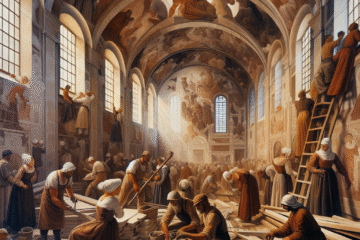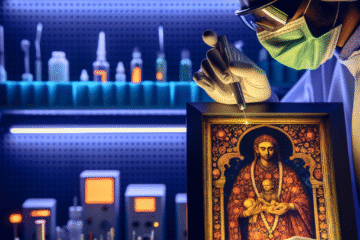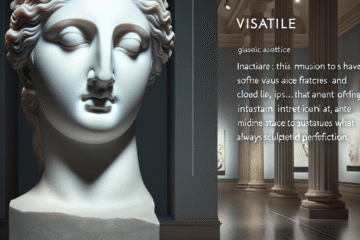I. Introduction
Art and technology have had a complex and evolving relationship throughout history. As technology has advanced, it has opened up new possibilities for artists to create and express themselves in different ways. From the camera obscura to digital art, technology has continuously impacted the development of art history.
This article will explore the historical progression of art and technology and its impact on the art world. It will examine the ways in which technological advancements have influenced artistic techniques and styles, as well as how artists have used technology to push the boundaries of what is considered “art”.
The thesis of this article is that technology has played a crucial role in the development of art history, allowing artists to experiment with new forms of expression and challenging traditional notions of what constitutes “art”. Through an analysis of the camera obscura, photography, and digital art, this article will demonstrate how technology has impacted the art world and what the future may hold for this relationship.
II. The Camera Obscura and Its Influence on Art
The camera obscura, which translates to “dark chamber” in Latin, was a device used to project images onto a surface through a small hole. This optical device was first described by the Chinese philosopher Mozi in the 5th century BCE and was later used by Arab scholars during the Islamic Golden Age. The camera obscura eventually made its way to Europe during the Renaissance period, where it was adopted by artists as a tool for creating more realistic and accurate depictions of the world around them.
The camera obscura allowed artists to accurately depict perspective, proportions, and lighting in their work. This tool allowed artists to trace the projected image onto a canvas or paper, which helped them create more realistic and detailed images. Additionally, the camera obscura helped artists better understand the principles of optics and how they could be used in art.
One of the most famous examples of an artist using the camera obscura is Leonardo da Vinci. In his painting “The Last Supper,” da Vinci used the camera obscura to accurately depict the vanishing point perspective of the room. Similarly, Johannes Vermeer used the camera obscura to create highly realistic depictions of light and shadow in his paintings, such as “The Music Lesson” and “The Astronomer”.
While the camera obscura was criticized by some as a mechanical and inauthentic way of creating art, its impact on the development of art history cannot be denied. The use of the camera obscura allowed artists to better understand and experiment with the principles of optics, leading to new techniques and styles in art.
In conclusion, the camera obscura played a significant role in the development of art during the Renaissance period. Its use allowed artists to create more realistic and accurate depictions of the world around them, and its influence can still be seen in art today. The camera obscura was just the beginning of a long history of art and technology, with more advancements to come.
III. Photography and Its Impact on Art
The invention of photography in the early 19th century revolutionized the art world, providing a new way for artists to capture and document the world around them. Unlike the camera obscura, which required the artist to trace the projected image, photography captured the image directly onto a surface through the use of light-sensitive materials.
Photography challenged traditional notions of art, as it was seen by some as a mechanical and impersonal process. However, many artists embraced photography as a new tool for artistic expression. The ability to capture a moment in time with photographic accuracy allowed artists to experiment with new styles and techniques.
One of the most significant impacts of photography on art was its ability to capture reality with a level of detail and accuracy previously unattainable. Photography allowed artists to capture landscapes, portraits, and scenes of daily life with unparalleled precision. This led to the emergence of new artistic styles, such as realism and naturalism, which sought to accurately depict the world as it was.
Famous photographers such as Ansel Adams, Henri Cartier-Bresson, and Diane Arbus made significant contributions to the development of photography as an art form. Adams is known for his stunning landscape photography, which captured the natural beauty of the American West. Cartier-Bresson is considered the father of modern photojournalism and is known for his candid street photography. Arbus challenged traditional notions of beauty and normalcy with her portraits of marginalized individuals, such as drag queens and circus performers.
Photography also paved the way for other technological advancements in art, such as the development of film and video art. The ability to capture and manipulate moving images allowed artists to experiment with new forms of storytelling and visual expression.
In conclusion, the invention of photography had a significant impact on the art world, challenging traditional notions of art and allowing artists to experiment with new techniques and styles. Famous photographers made significant contributions to the development of photography as an art form, paving the way for future technological advancements in art.
IV. The Rise of Digital Art
The rise of digital art has brought new possibilities to the art world, challenging traditional notions of art and expanding the ways in which artists can create and express themselves. Digital art refers to any art form that is created using digital technology, such as computer graphics, digital painting, and animation.
Digital art emerged in the 1960s with the development of computer technology, and it has since grown in popularity and sophistication. The ability to create and manipulate images digitally has allowed artists to experiment with new forms of visual expression, such as glitch art and generative art.
One of the most significant impacts of digital technology on art is its ability to democratize the art world. With digital tools readily available, artists can create and distribute their work to a global audience without the need for expensive materials or gallery space. This has led to the emergence of new art communities online, where artists can share their work and collaborate with others.
Digital technology has also challenged traditional notions of art, as it blurs the lines between what is considered “real” and “artificial.” The use of digital tools allows artists to create images and experiences that are not bound by physical reality, leading to new forms of abstract and conceptual art.
Digital art has the potential to create immersive and interactive experiences that engage the viewer in new ways. Examples of digital art range from video game art and virtual reality installations to algorithmic art and interactive sculptures. The possibilities are endless, as artists continue to push the boundaries of what is possible with digital technology.
In conclusion, the rise of digital art has had a significant impact on the art world, challenging traditional notions of art and expanding the ways in which artists can create and express themselves. Digital technology has democratized the art world, allowing artists to reach a global audience and collaborate with others online. The potential of digital art is vast, as artists continue to explore the possibilities of digital technology and create new forms of art that challenge our perceptions of reality.
V. The Future of Art and Technology
The intersection of art and technology has continued to evolve and grow in recent years, with new advances in technology presenting new possibilities for artists to explore. As technology continues to advance, it is likely that it will have an even greater impact on the art world in the future.
One of the potential benefits of incorporating technology into art is the ability to create more immersive and interactive experiences for viewers. For example, virtual reality and augmented reality technology allow artists to create immersive installations that engage the viewer in new and exciting ways. The use of technology also presents new possibilities for collaboration and community building, as artists can work together remotely and share their work with a global audience.
However, incorporating technology into art also presents challenges. For example, the use of digital tools can raise questions about the authenticity and value of the artwork. Additionally, the cost of technology and the need for technical skills may limit access to digital art creation for some artists.
Despite these challenges, there are many exciting current trends and projects that illustrate the intersection of art and technology. For example, AI-generated art is becoming increasingly popular, with algorithms being used to create abstract and surreal images. Additionally, the use of blockchain technology is changing the way that art is bought and sold, providing new opportunities for artists to monetize their work and for collectors to invest in art.
The use of technology in public art installations is also growing, with artists using projection mapping and other technologies to create interactive and dynamic installations in public spaces. For example, the artist Rafael Lozano-Hemmer created a large-scale public art installation that used heart rate monitors to create a light display that was responsive to the heartbeats of the participants.
In conclusion, advances in technology will continue to shape the art world in the future, presenting both opportunities and challenges for artists. The use of technology has the potential to create more immersive and interactive art experiences and to democratize the art world, but it also raises questions about authenticity and access. Nonetheless, the intersection of art and technology is an exciting area for artists to explore and experiment with in the coming years.
VI. Conclusion
Throughout history, art and technology have had a complex and evolving relationship. From the camera obscura to digital art, technology has continuously impacted the development of art history, allowing artists to experiment with new forms of expression and challenging traditional notions of what constitutes “art”.
In this article, we explored the historical progression of art and technology, from the camera obscura and its impact on Renaissance art, to the invention of photography and its influence on artistic techniques and styles, to the rise of digital art and its potential for creating immersive and interactive experiences for viewers.
While each technological advancement presented its own set of challenges and opportunities for artists, it is clear that technology has played a crucial role in the development of art history. The use of technology has allowed artists to push the boundaries of what is considered “art” and to create new forms of visual expression that engage and challenge viewers in exciting new ways.
Looking to the future, it is clear that advances in technology will continue to shape the art world, presenting new opportunities and challenges for artists. The use of technology in art is likely to become even more prevalent and sophisticated, providing new possibilities for collaboration, community building, and immersive experiences.
In conclusion, the intersection of art and technology is an exciting area of exploration for artists and scholars alike. As technology continues to advance, it will be interesting to see how it will shape the future of art history and what new forms of art will emerge as a result.


